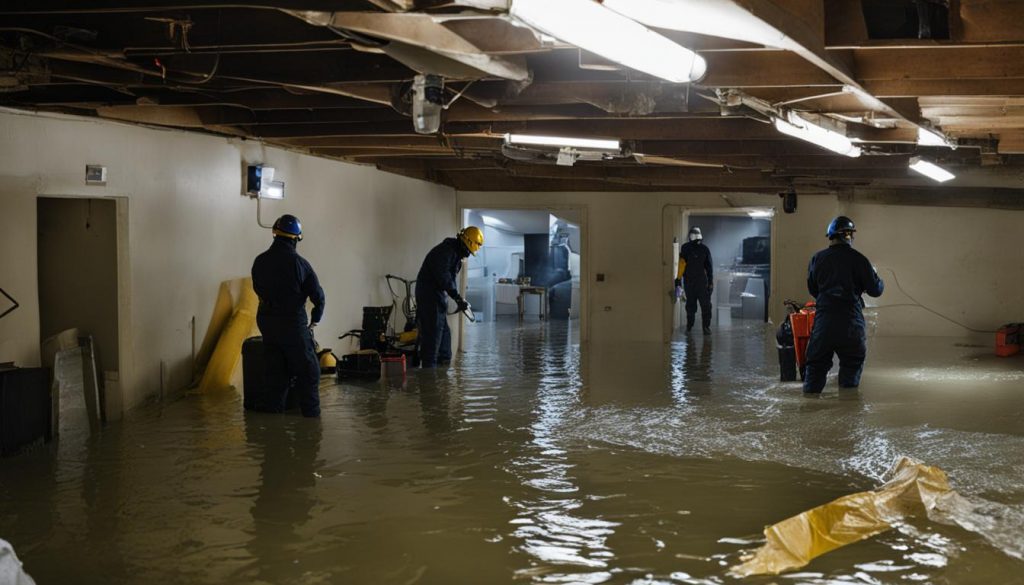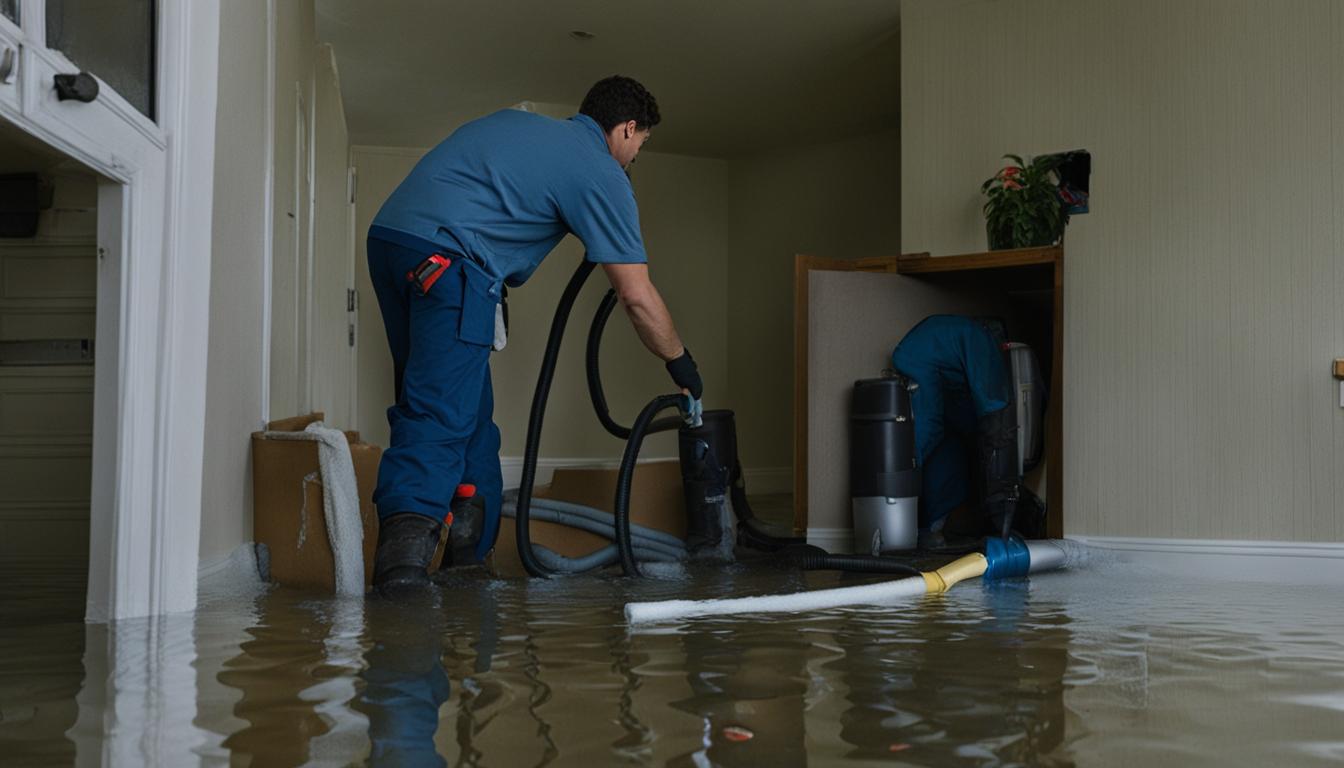Water damage can be a distressing and costly problem that can occur in any home or property. Whether it’s caused by a burst pipe, a leaky roof, or a natural disaster, addressing water damage promptly is crucial to prevent further structural damage and potential health hazards.
If you’re facing the daunting task of clearing water damage, it’s important to understand the necessary steps and precautions to take. This article will guide you through the process of water damage restoration, cleanup, and repair, providing you with essential information to tackle the situation effectively and efficiently.
- Unplug all electronics and appliances before addressing water damage for safety.
- Use a wet/dry vacuum to remove excess water.
- Steam clean water-damaged carpets and disinfect walls and floors to prevent bacteria buildup.
- Apply a product to inhibit mold growth.
- Utilize fans and dehumidifiers to dry out the affected area.
Steps to Clear Water Damage
To effectively address water damage in your home, it is crucial to follow a systematic process. By taking the right steps, you can restore your property and prevent further damage. Follow these guidelines to clear water damage and ensure a successful water damage restoration process.
1. Unplug Electronics and Appliances
Before you start removing water, prioritize safety by unplugging all electronics and appliances. This step prevents the risk of electrical shock or damage to your devices.
2. Use a Wet/Dry Vacuum
To remove excess water, employ a wet/dry vacuum. This versatile tool will help extract water efficiently and prevent further saturation of the affected area.
3. Steam Clean Wet Carpets
If your carpets have suffered water damage, steam cleaning is necessary to remove moisture and reduce the potential for mold growth. Steam cleaning effectively restores carpets to their original condition.
4. Disinfect Walls and Floors
Prevent bacteria buildup in the affected area by thoroughly disinfecting the walls and floors. A disinfectant cleaner will eliminate any potential health hazards caused by water damage.
5. Apply Mold Growth Inhibitor
To mitigate the development of mold, apply a product that inhibits mold growth. This proactive measure will safeguard your home against the harmful effects of mold and help maintain a healthy indoor environment.
6. Utilize Fans and Dehumidifiers
Finally, accelerate the drying process by using fans and dehumidifiers to reduce humidity levels. These devices create airflow and promote faster evaporation, effectively drying out the space and preventing further damage.
Following these steps will help you clear water damage effectively and efficiently. By taking immediate action and addressing the issue promptly, you can minimize the impact of water damage on your home and belongings. Proceed to the next section to learn about the different types of water and their respective cleanup processes.
Types of Water and their Cleanup
When it comes to water damage, not all water is created equal. There are three main types of water that can cause damage to your property – clean water, gray water, and black water.
Clean Water Damage Cleanup
The first type of water damage is caused by clean water, which typically comes from rain, leaky pipes, or overflowing sinks. Cleaning up clean water damage can often be done on your own, but it’s important to act quickly to prevent further damage. Begin by unplugging all electronics and appliances in the affected area. Then, use a wet/dry vacuum to carefully remove as much water as possible. This helps minimize the risk of electrical hazards and reduces the potential for long-term structural damage.
Gray Water Damage Cleanup
The second type of water damage is caused by gray water, which includes water from dishwashers, washing machines, and clean toilets. Gray water may contain bacteria and other contaminants, making it potentially harmful to your health. Therefore, it is advisable to seek professional cleaning services for gray water damage cleanup. Professionals have the expertise and specialized equipment to thoroughly clean and disinfect the affected area, ensuring a safe and sanitary environment.
Black Water Damage Cleanup
The third and most severe type of water damage is caused by black water, which includes sewage backups, serious flooding, and water from natural disasters. Black water contains dangerous pathogens, bacteria, and other hazardous substances that pose significant health risks. Cleaning up black water damage requires the expertise of professionals who are equipped to handle the cleanup process safely. They have the necessary protective gear, advanced cleaning techniques, and industry-standard disinfectants to ensure the removal of all contaminants and prevent the spread of diseases.
The cost of water damage cleanup can vary depending on the severity of the damage and the type of water involved. It is important to assess the situation carefully and consult with professionals to determine the most appropriate course of action for your specific water damage scenario.
Understanding the different types of water and their cleanup requirements is crucial when dealing with water damage. Whether it’s clean water, gray water, or black water, taking immediate action and seeking professional assistance when necessary can help mitigate the damage and ensure the safety of your property and your health.
Assessing and Repairing Water Damage
Before starting the repair process, it is crucial to assess the severity of the water damage. By taking the following steps, you can effectively evaluate the extent of the damage and determine the appropriate course of action:
- Identify the source of the water: Begin by identifying the source of the water to prevent further damage. It could be a burst pipe, roof leak, or a faulty appliance. Once identified, take immediate action to stop the water flow.
- Ensure safety: Safety should always be a top priority when dealing with water damage. Turn off the power supply to the affected area to avoid any electrical hazards. If necessary, wear protective gear, such as gloves and masks, to minimize exposure to contaminants.
- Remove wet items: Once the source of the water has been addressed and the area is safe, remove any wet items from the affected space. This includes furniture, carpets, and personal belongings. Promptly removing wet items can prevent further damage and mold growth.
- Dry out the space: To expedite the drying process, use fans and dehumidifiers to circulate air and remove excess moisture. Open windows and doors to improve ventilation. Consider renting professional drying equipment if the damage is extensive.
- Professional assistance: In cases of severe water damage, it is advisable to seek the expertise of a water restoration professional. They have the necessary equipment and knowledge to handle extensive damage and can provide mold inspection and remediation services if required.
Assessing and repairing water damage requires a systematic approach and attention to detail. By following these steps, you can effectively manage the restoration process and restore your property to its pre-damaged condition.

| Assessment Steps | Benefits |
|---|---|
| Identify the source of the water | – Prevent further damage – Enable targeted repairs |
| Ensure safety | – Minimize electrical hazards – Reduce health risks |
| Remove wet items | – Prevent mold growth – Salvage personal belongings |
| Dry out the space | – Prevent structural damage – Discourage mold growth |
| Professional assistance | – Expertise in handling extensive damage – Mold inspection and remediation |
Insurance and Water Damage Claims
Dealing with water damage in your home can be a stressful and costly experience. Fortunately, if you have homeowners insurance, you may be able to file a water damage insurance claim and receive reimbursement for the cleaning and repair costs. To ensure a smooth claims process, it is important to follow the necessary steps and provide the required documentation.
When faced with water damage, the first step is to contact your insurance company immediately to report the incident. Be prepared to provide details about the cause of the damage, the extent of the damage, and any steps you have taken to mitigate further losses.
Tip: Take photographs of the water damage to document the extent and severity of the situation. This visual evidence can support your insurance claim.
Once your insurance company has been notified, they will guide you through the claims process. They may assign an adjuster to assess the damage and determine the coverage you are eligible for based on your policy.
Tip: Keep track of any expenses related to the water damage, including cleaning supplies, repairs, and temporary accommodations if necessary. These costs can be included in your claim for reimbursement.
Depending on your policy coverage, you may be responsible for paying a deductible before your insurance kicks in. The insurance company will then provide you with the necessary guidance to proceed with the restoration process.
In some cases, the insurance company may recommend mold remediation specialists and water damage repair professionals to help restore your property. They may have partnerships with trusted service providers or provide a list of approved vendors.
Tip: It is important to review your homeowners insurance policy periodically to ensure you have the necessary coverage for water damage.
By promptly reporting the water damage and providing the required documentation, you can increase the chances of a successful water damage insurance claim. Remember to keep all communications and paperwork related to your claim for future reference.
Tip: If you encounter any difficulties or disputes during the claims process, consult with a public adjuster or seek legal advice to protect your rights as a policyholder.
Dealing with water damage is challenging, but having homeowners insurance can provide financial relief in such situations. By understanding the claims process and working closely with your insurance company, you can restore your home and regain peace of mind.
Key Points:
- Contact your insurance company immediately to report the water damage.
- Document the extent of the damage with photographs.
- Keep track of all expenses related to the water damage for reimbursement.
- Review your homeowners insurance policy to ensure adequate coverage for water damage.
- Follow the guidance of your insurance company and consider their recommendations for professional help.
- Consult a public adjuster or seek legal advice if you encounter difficulties with your claim.
Preventing Future Water Damage
Preventing water damage is essential to protect your home and belongings. By taking proactive measures, you can avoid costly repairs and the hassle of dealing with water damage. Here are some steps you can take to prevent future water damage:
1. Identify the Cause of Water Intrusion
To effectively prevent water damage, it is important to identify the source of water intrusion. Common causes include leaky pipes, damaged roofs, and poor drainage. Regularly inspect your home for any signs of leakage or water seepage.
2. Improve Drainage Around Your Home’s Foundation
Poor drainage can lead to water pooling around your home’s foundation, increasing the risk of water damage. Ensure that your gutters and downspouts are clean and properly directed away from the foundation. Consider installing French drains or other drainage systems to divert water away from your home.
3. Conduct Regular Inspections
Regular inspections of appliances, plumbing systems, and roofing are crucial in identifying potential issues before they escalate into major water damage problems. Look for signs of leaks, corrosion, or any other damage that may indicate a potential water issue.
4. Maintain Proper Ventilation and Humidity Levels
Excess moisture in your home can lead to mold growth and water damage. Ensure that your home is properly ventilated, especially in areas prone to moisture, such as bathrooms and kitchens. Use exhaust fans and dehumidifiers to control humidity levels and prevent condensation.
5. Address Issues Promptly
If you notice any signs of water damage or potential issues, such as a musty smell, stains, or water spots, take immediate action. Fixing small leaks or addressing minor issues promptly can help prevent them from turning into major water damage problems.
6. Invest in Water Leak Detection Systems
Consider installing water leak detection systems in your home, especially in areas prone to water damage, such as basements or laundry rooms. These systems can detect leaks early on and alert you, allowing you to take immediate action to prevent further damage.
By following these preventive measures, you can significantly reduce the risk of water damage in your home and ensure its long-term safety and protection.
Conclusion
Clearing water damage is a critical task that requires immediate attention to prevent further damage and potential health hazards. By following the step-by-step process outlined in this article, you can effectively restore your property from water damage. Remember to prioritize safety by unplugging electronics and appliances, and use a wet/dry vacuum to remove excess water.
In addition to cleaning, it is crucial to document the damage for insurance purposes. Taking photographs and keeping track of expenses will help with the water damage insurance claim process. For extensive damage, seeking professional assistance from water damage repair experts is highly recommended.
Prevention is key to minimizing the risk of future water damage incidents. Regular inspections of plumbing, appliances, and roofing can detect potential issues before they escalate. Improving drainage around your home’s foundation and maintaining proper ventilation will also offer protection against water intrusion and mold growth.
By taking swift action, documenting the damage, considering professional help, and adopting preventive measures, you can effectively manage water damage cleanup and repair, ensuring the safety and longevity of your property.
FAQ
How do you clear water damage?
To effectively clear water damage, unplug all electronics and appliances for safety. Use a wet/dry vacuum to remove water, steam clean carpets, and disinfect walls and floors. Apply a product to prevent mold growth and use fans and a dehumidifier to dry the space.
What are the steps to clear water damage?
The steps to clear water damage are: unplug electronics, use a wet/dry vacuum, steam clean carpets, disinfect walls and floors, apply a mold prevention product, and use fans and a dehumidifier to dry the space.
What are the types of water and how do you clean them up?
The types of water that can cause damage are clean water, gray water, and black water. Clean water damage can be cleaned up by unplugging everything and using a wet/dry vacuum. Gray water damage may require professional cleaning. Black water damage should be addressed by professionals due to the health risks involved.
How do you assess and repair water damage?
To assess and repair water damage, identify the source of the water, turn off power, remove wet items, and use fans and dehumidifiers to dry the space. For extensive damage, it is recommended to contact a water restoration professional.
How do you handle insurance and water damage claims?
Contact your insurance company to report the water damage and start the claims process. Document the damage with photographs and keep track of expenses. Depending on your insurance coverage, you may be eligible for reimbursement for cleaning and repair costs.
How can you prevent future water damage?
To prevent future water damage, improve drainage around your home’s foundation, regularly inspect appliances/plumbing/roofing, and maintain proper ventilation and humidity levels to prevent mold growth.









